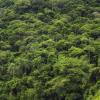
Forest restoration has high-level political support: the UN declared 2021-2030 the decade of restoration, and governments have committed to restore 350 million ha of forest by 2030 under the Bonn Challenge. However, there is strong debate about where and how restoration should take place, and what benefits forest restoration could provide for carbon sequestration and storage, biodiversity, and people’s livelihoods.
Growing interest in forest restoration sounds like a good thing, but could have unintended consequences because natural ecosystems and the economy are globally connected through consumption, production and trade. Loss of primary and intact natural forest ecosystems is ongoing, as increasing demand for agricultural and bioenergy crops drives expansion of cultivated land. Adding forest restoration into landscapes could increase pressure on existing forests by taking up space that could be allocated for cultivation, displacing land demand to forest frontiers. Understanding how meeting forest restoration targets impacts tele-coupled land use systems through production and trade is particularly critical in countries that retain high forest cover and have exceptional globally-significant biodiversity – such as Colombia.
A first key question is: is there space for forest restoration in land use systems, and would meeting forest restoration targets have impacts on deforestation rates through displaced demand for agricultural land? A second key question is: how could widespread forest restoration impact biodiversity at subnational or national scales, taking into account primary forest loss and restored forest gains?
During my NERC-IIASA Collaborative Fellowship, held between Bangor University (Wales, UK) and IIASA, I use two modelling tools to understand the magnitude and spatial arrangement of forest loss and gain using policy-informed scenarios of forest restoration. I work with the Integrated Biosphere Futures group at IIASA, and members of the FABLE Consortium/United Nations Sustainable Development Solutions Network, to adapt the partial equilibrium spatial economic model GLOBIOM to the Colombian context. I also work with a probabilistic statistical model of forest loss and gain to understand finer-scale processes of forest cover change. I use both models to project scenarios of forest regrowth and deforestation, and outcomes for agricultural production, for the coming decades.
I also work with the Biodiversity, Ecology and Conservation group, and the Humboldt Institute in Colombia (Instituto de Investigación de Recursos Biológicos Alexander von Humboldt) to use cutting-edge ecological modelling methods to understand how Colombia’s exceptional biodiversity may respond under scenarios of land use change.
Answering these questions is critical as countries start to implement restoration targets, in the hope of meeting both climate and biodiversity targets while delivering sustainable food systems and supporting livelihoods.
